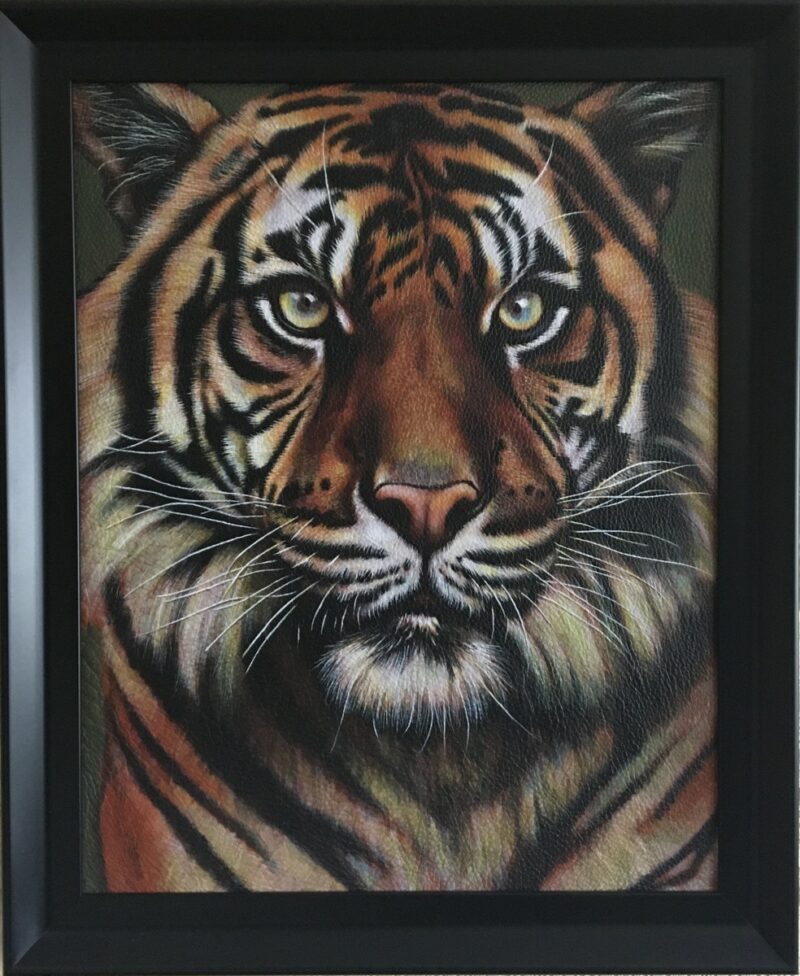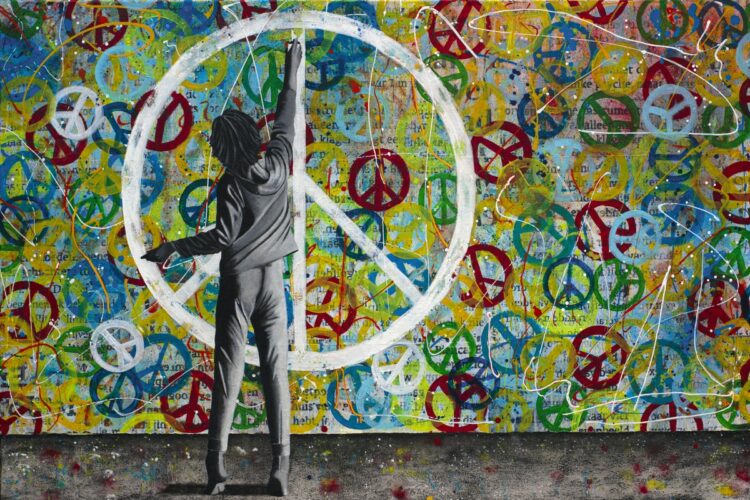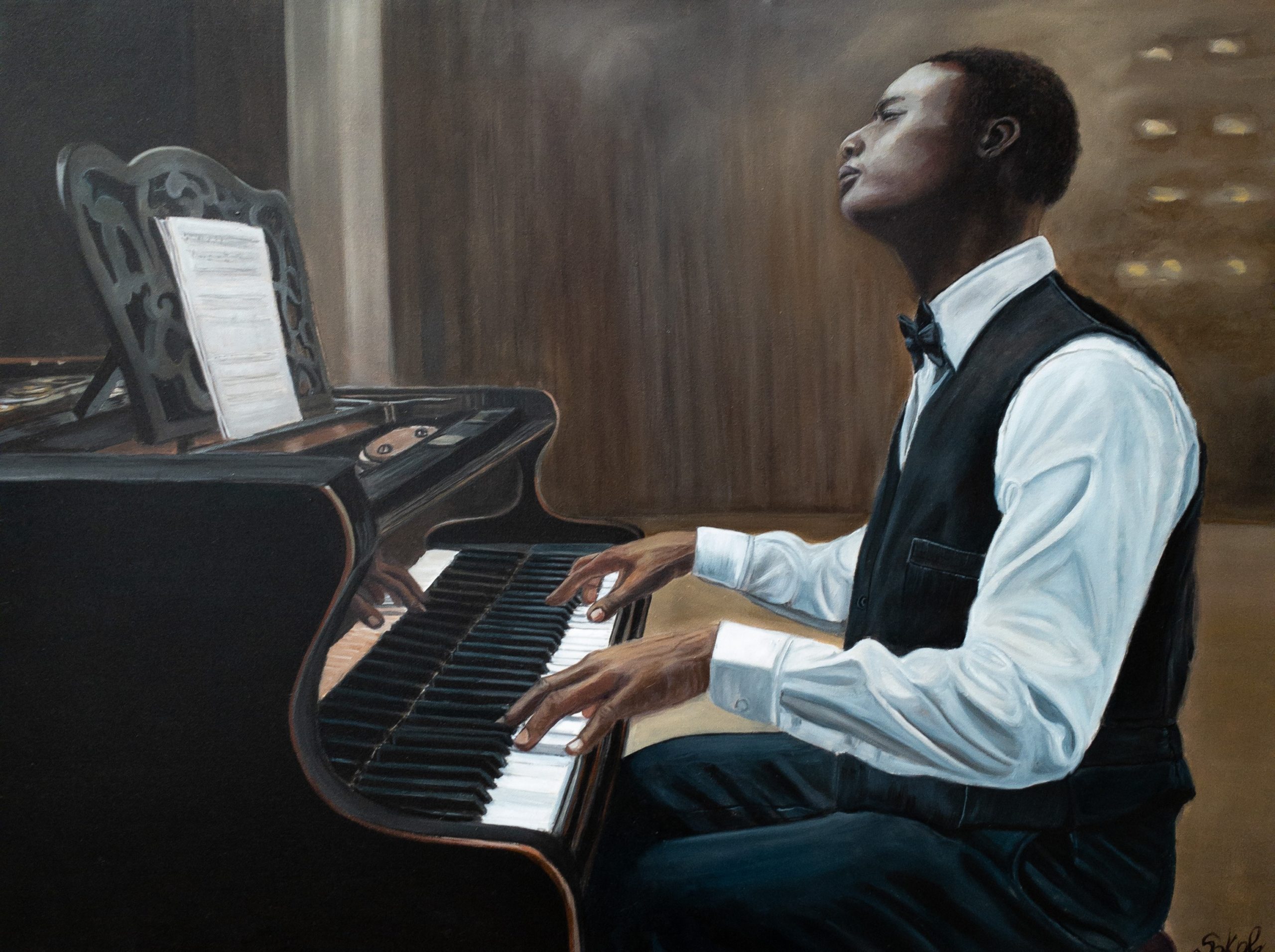Tiger: Tala by Karl Hamilton-Cox
Our Artwork of the Week, titled “Tiger: Tala” by the talented artist Karl Hamilton-Cox, is a mesmerising piece that captures the essence and raw power of a majestic tiger. Created using special acrylics on black leather, this original hand-painted portrait is framed in black, enhancing its striking presence. The artist’s masterful technique and attention to detail result in a remarkably realistic depiction of the tiger’s head.
The focal point of the painting is undoubtedly the tiger’s intense stare, which pierces through the canvas and directly engages the viewer. The artist skilfully captures the essence of the tiger’s gaze, conveying both its strength and vulnerability. The contrast between the tiger’s piercing eyes and the black background further intensifies the impact of the artwork, creating a sense of depth and mystery.
Karl’s choice of medium and technique plays a vital role in the overall effect of the painting. The use of special acrylics on black leather adds a unique texture and depth to the artwork, bringing the tiger to life in a truly captivating manner. The meticulous brushstrokes and intricate details, such as the tiger’s fur and whiskers, contribute to the overall realism and stunning quality of the piece.
In its entirety, “Tiger: Tala” by Karl Hamilton-Cox is a remarkable testament to the artist’s talent and dedication. The artwork’s bold presence, combined with the artist’s impeccable execution, creates a captivating visual experience that is sure to leave a lasting impression on anyone fortunate enough to behold it.
VIEW ALL PAINTING BY KARL HAMILTON-COX
Questions to the Artist about the Artwork
What inspired you to choose a tiger as the subject for this particular artwork?
One of my first wildlife paintings was a Tiger so it is always a favourite subject of mine to do. When I was growing up in Singapore in the late 1960’s, visits to the Tiger Balm Gardens (now the Haw Par Villa) and seeing the sculptures there fascinated me. For this Tiger painting I wanted to do a portrait with a gaze that ‘followed you around’ whichever angle you looked at it (similar to the WW1 Lord Kitchener recruitment poster.) I took quite some time to find the right reference material to portray what I wanted. Once the copyright licence was secured, I got to work preparing a suitable piece of black leather with the appropriate texture and grain.
Can you describe the process of using special acrylics on black leather and how it contributes to the overall effect of the painting?
I have developed this painting process for my quite unique leather wall art, sourcing and selecting the colour and texture of leather that must add value to the artwork. Fabric canvas has too much of a regular weaved structure for such a natural subject, flat panel is too clinical so this is where adapting the natural texture and colours of each type of hide I select complements elements of the composition. Lightly textured leather does help the painting of fur, my Elephant paintings on heavily textured leather does add a slightly 3D effect.
The selected leather is prepared and fixed to a 3mm backing board so there is a flat and stable surface to paint on. As an artist I find the ability to do glazing in dozens of transparent layers that gives a depth of colour which would be difficult for paper to handle without it disintegrating.
Normal art shop acrylic paint does not work on leather so there is a process of using special leather paints that matches my painting style. The process is to correctly prepare the surface to be painted and once painted to seal it. There are a couple of advantages of painting on leather, the finish is very durable and does not need protecting behind glass. I encourage the painted surface to be touched! There is of course the aroma of leather. I also paint art on leather jackets and the same process applies; the finish is flexible, wear resistant and waterproof.
I live in Hereford and the Cathedral here has and exhibits the Mappa Mundi, the early mediaeval map of the known world – painted on leather.
What techniques did you employ to create the intricate details of the tiger’s fur and whiskers?
I work on proportions and tones being the initial stages and gradually build up the layers picking out the detail as I go. It is critical when painting any wildlife with fur to ensure that the direction, size and flow of the fur is correct, for example you can see that the fur on a Tiger’s nose is different to that elsewhere.
The early stages of painting fur are with an old ‘damaged’ brush then as the form takes shape I switch to finer round brushes in proportion to the type of fur being painted, thousands of brushstrokes are necessary to build up the appearance of texture. The final stage is adding the highlights, in the case of a Tiger I turn the painting so that the direction of my paint brush matches the natural arc my arm moves in the direction that the fur lies; this gives a more natural, effortless and fluid movement.
Fur and whiskers have form and texture so are not just lines, they are circular and there are highlights, shadows and colours that need to be shown. I use my favourite script liner brush for this. Whiskers are usually the last elements to be painted.
Paying close attention to any reference material is critical, especially replicating realism, only then do I take any artistic licence. This painting is a record and I owe it to the subject and viewer to get the technical accuracy correct.
What emotions or messages do you hope viewers take away from “Tiger: Tala”?
I find the endangered status of many of the wildlife subjects I paint extremely sad. I used to live and work in Borneo back in the late 1990’s and was very close to the wildlife, witnessing how the rapid encroachment of humans was devastating the natural environment. I wanted to portray the emotions from the Tiger watching us (to see what we do next) whilst maintaining an air of majestic dignity – from whatever angle the painting is being viewed from. We cannot escape from our responsibilities and Tala is watching.
VIEW ALL PAINTING BY KARL HAMILTON-COX




